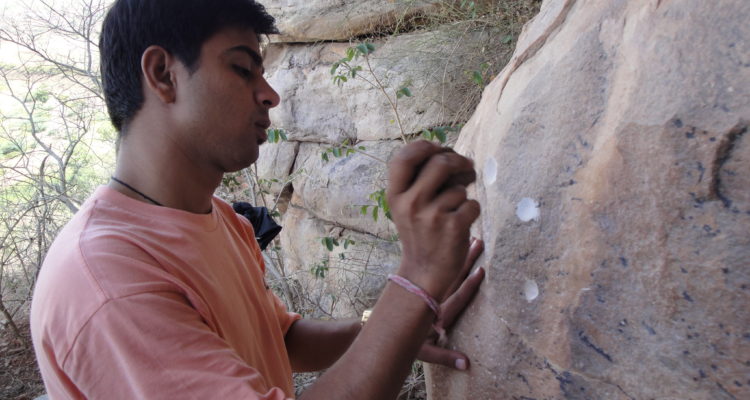Rock art is found in two forms: iconic and non-iconic, and has been created on bare rock surface either by additive technique (by applying pigment on rock, such as different kinds of rock paintings or by reductive technique (by bringing out something from rock, such as different kind of petroglyphs executed by engraving, carving, pecking, scratching and bruising (abrasion) techniques.
In India rock paintings have been done generally in mineral colours, mostly in different shades of red, obtained from naturally available haematite and other forms of iron oxide nodules. The pigment is obtained by rubbing these nodules on rock surface along with water. Sometimes, white pigment obtained from kaolin (calcium carbonate) and occasionally terra verta green (earthen colour) and manganese black have also been used. In Indian rock art, unlike European cave art, use of charcoal is very rare, that too in the late historic figures. So far we are not sure that any organic binders were used in Indian rock paintings by the artists of Stone Age. That is why our efforts to obtain AMS 14C dates for early Indian rock paintings were not very successful.
Figures have been painted by using thick to fine brush probably made of plant twigs and other natural things in different times. Sometimes, paint was applied with the help of fingers and hands dipped in colour paste (in case of hand prints). Hand stencils were also created by taking the liquid paint in mouth and spraying it on the hand.
Petroglyphs are found both in the form of iconic and non-iconic forms executed in the form of cupules, engravings, motifs made of cupules, engravings, a combination of both of them, abrasion and chiselling. The creation of petroglyphs, especially cupules by direct percussion technique is a tedious and time consuming task (Krishna and Kumar 2012a, 2012b, 2012c and Kumar and Krishna 2014).
All the people of India in early Holocene period were tribes living in groups (kabilas), following hunting-foraging life of Mesolithic age (using microliths and implements made of them). Rock art is one of the medium in which they manifested their creative ideas, thoughts and beliefs. Some of them learned domestication of animals, especially cattle which led the foundation of pastoral economy. Later on some of them also learned cultivating crops, thus began the agro-pastoral economy at different times in different parts of India. This change in economy also brought a radical change in the socio-cultural life of the people, so also in their artistic activities. The tribes living in the forests and early pastorals living in the nearby areas continued the tradition of making rock art. It appears that those living in the plains in the villages and cities transformed the rock art tradition into decorating the walls of their houses and potteries and other articles of their use as seen on the potteries of the Chalcolithic and Bronze Age cultures in Vedic period on wards. The wall paintings in the caves of Ajanta, Ellora, Pitalkhora and Bagh are the classical examples of the continuity of this creative tradition.


Leave a Reply